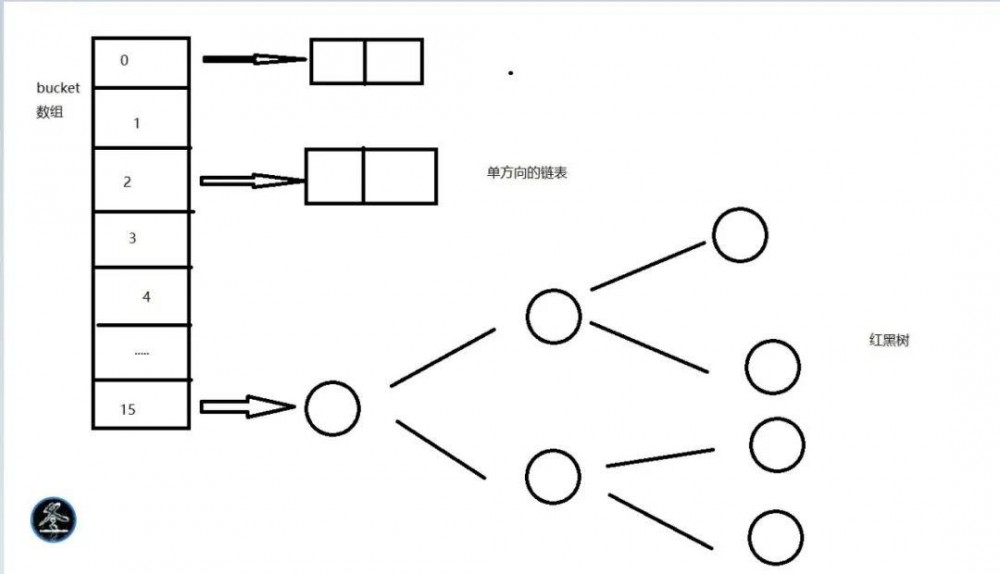面试必问:HashMap 底层实现原理

HashMap是在面试中经常会问的一点,很多时候我们仅仅只是知道HashMap他是允许键值对都是Null,并且是非线程安全的,如果在多线程的环境下使用,是很容易出现问题的。 这是我们通常在面试中会说的,但是有时候问到底层的源码分析的时候,为什么允许为Null,为什么不安全,这些问题的时候,如果没有分析过源码的话,好像很难回答, 这样的话我们来研究一下这个源码。看看原因吧。
HashMap最早出现在JDK1.2中,它的底层是基于的散列算法。允许键值对都是Null,并且是非线程安全的,我们先看看这个1.8版本的JDK中HashMap的数据结构吧。
HashMap图解如下

我们都知道HashMap是数组+链表组成的,bucket数组是HashMap的主体,而链表是为了解决哈希冲突而存在的,但是很多人不知道其实HashMap是包含树结构的,但是得有一点 注意事项,什么时候会出现红黑树这种红树结构的呢?我们就得看源码了,源码解释说默认链表长度大于8的时候会转换为树。我们看看源码说的
结构
/** * Basic hash bin node, used for most entries. (See below for * TreeNode subclass, and in LinkedHashMap for its Entry subclass.) */ /** Node是hash基础的节点,是单向链表,实现了Map.Entry接口 */static class Node<K,V> implements Map.Entry<K,V> { final int hash; final K key; V value; Node<K,V> next; //构造函数 Node(int hash, K key, V value, Node<K,V> next) { this.hash = hash; this.key = key; this.value = value; this.next = next; } public final K getKey() { return key; } public final V getValue() { return value; } public final String toString() { return key + "=" + value; } public final int hashCode() { return Objects.hashCode(key) ^ Objects.hashCode(value); } public final V setValue(V newValue) { V oldValue = value; value = newValue; return oldValue; } public final boolean equals(Object o) { if (o == this) return true; if (o instanceof Map.Entry) { Map.Entry<?,?> e = (Map.Entry<?,?>)o; if (Objects.equals(key, e.getKey()) && Objects.equals(value, e.getValue())) return true; } return false; }}复制代码
接下来就是树结构了
TreeNode 是红黑树的数据结构。
/** * Entry for Tree bins. Extends LinkedHashMap.Entry (which in turn * extends Node) so can be used as extension of either regular or * linked node. */ static final class TreeNode<K,V> extends LinkedHashMap.Entry<K,V> { TreeNode<K,V> parent; // red-black tree links TreeNode<K,V> left; TreeNode<K,V> right; TreeNode<K,V> prev; // needed to unlink next upon deletion boolean red; TreeNode(int hash, K key, V val, Node<K,V> next) { super(hash, key, val, next); } /** * Returns root of tree containing this node. */ final TreeNode<K,V> root() { for (TreeNode<K,V> r = this, p;;) { if ((p = r.parent) == null) return r; r = p; } }复制代码
我们在看一下类的定义
public class HashMap<K,V> extends AbstractMap<K,V> implements Map<K,V>, Cloneable, Serializable {复制代码
继承了抽象的map,实现了Map接口,并且进行了序列化。
在类里还有基础的变量
变量
/** * The default initial capacity - MUST be a power of two. * 默认初始容量 16 - 必须是2的幂 */static final int DEFAULT_INITIAL_CAPACITY = 1 << 4; // aka 16/** * The maximum capacity, used if a higher value is implicitly specified * by either of the constructors with arguments. * MUST be a power of two <= 1<<30. * 最大容量 2的30次方 */static final int MAXIMUM_CAPACITY = 1 << 30;/** * The load factor used when none specified in constructor. * 默认加载因子,用来计算threshold */ static final float DEFAULT_LOAD_FACTOR = 0.75f;/** * The bin count threshold for using a tree rather than list for a * bin. Bins are converted to trees when adding an element to a * bin with at least this many nodes. The value must be greater * than 2 and should be at least 8 to mesh with assumptions in * tree removal about conversion back to plain bins upon * shrinkage. * 链表转成树的阈值,当桶中链表长度大于8时转成树 * threshold = capacity * loadFactor */static final int TREEIFY_THRESHOLD = 8;/** * The bin count threshold for untreeifying a (split) bin during a * resize operation. Should be less than TREEIFY_THRESHOLD, and at * most 6 to mesh with shrinkage detection under removal. * 进行resize操作时,若桶中数量少于6则从树转成链表 */static final int UNTREEIFY_THRESHOLD = 6;/** * The smallest table capacity for which bins may be treeified. * (Otherwise the table is resized if too many nodes in a bin.) * Should be at least 4 * TREEIFY_THRESHOLD to avoid conflicts * between resizing and treeification thresholds. * 桶中结构转化为红黑树对应的table的最小大小 * 当需要将解决 hash 冲突的链表转变为红黑树时, * 需要判断下此时数组容量, * 若是由于数组容量太小(小于 MIN_TREEIFY_CAPACITY ) * 导致的 hash 冲突太多,则不进行链表转变为红黑树操作, * 转为利用 resize() 函数对 hashMap 扩容 */static final int MIN_TREEIFY_CAPACITY = 64;/** * The table, initialized on first use, and resized as * necessary. When allocated, length is always a power of two. * (We also tolerate length zero in some operations to allow * bootstrapping mechanics that are currently not needed.) * 保存Node<K,V>节点的数组 * 该表在首次使用时初始化,并根据需要调整大小。 分配时, * 长度始终是2的幂。 */transient Node<K,V>[] table;/** * Holds cached entrySet(). Note that AbstractMap fields are used * for keySet() and values(). * 存放具体元素的集 */transient Set<Map.Entry<K,V>> entrySet;/** * The number of key-value mappings contained in this map. * 记录 hashMap 当前存储的元素的数量 */transient int size;/** * The number of times this HashMap has been structurally modified * Structural modifications are those that change the number of mappings in * the HashMap or otherwise modify its internal structure (e.g., * rehash). This field is used to make iterators on Collection-views of * the HashMap fail-fast. (See ConcurrentModificationException). * 每次更改map结构的计数器 */transient int modCount;/** * The next size value at which to resize (capacity * load factor). * 临界值 当实际大小(容量*填充因子)超过临界值时,会进行扩容 * @serial */// (The javadoc description is true upon serialization.// Additionally, if the table array has not been allocated, this// field holds the initial array capacity, or zero signifying// DEFAULT_INITIAL_CAPACITY.)int threshold;/** * The load factor for the hash table. * 负载因子:要调整大小的下一个大小值(容量*加载因子)。 * @serial */final float loadFactor;复制代码
我们再看看构造方法
构造方法
/** * Constructs an empty <tt>HashMap</tt> with the specified initial * capacity and the default load factor (0.75). * * @param initialCapacity the initial capacity. * @throws IllegalArgumentException if the initial capacity is negative. * 传入初始容量大小,使用默认负载因子值 来初始化HashMap对象 */public HashMap(int initialCapacity) { this(initialCapacity, DEFAULT_LOAD_FACTOR);}/** * Constructs an empty <tt>HashMap</tt> with the default initial capacity * (16) and the default load factor (0.75). * 默认容量和负载因子 */public HashMap() { this.loadFactor = DEFAULT_LOAD_FACTOR; // all other fields defaulted}/** * Constructs an empty <tt>HashMap</tt> with the specified initial * capacity and load factor. * * @param initialCapacity the initial capacity * @param loadFactor the load factor * @throws IllegalArgumentException if the initial capacity is negative * or the load factor is nonpositive * 传入初始容量大小和负载因子 来初始化HashMap对象 */public HashMap(int initialCapacity, float loadFactor) { // 初始容量不能小于0,否则报错 if (initialCapacity < 0) throw new IllegalArgumentException("Illegal initial capacity: " + initialCapacity); // 初始容量不能大于最大值,否则为最大值 if (initialCapacity > MAXIMUM_CAPACITY) initialCapacity = MAXIMUM_CAPACITY; //负载因子不能小于或等于0,不能为非数字 if (loadFactor <= 0 || Float.isNaN(loadFactor)) throw new IllegalArgumentException("Illegal load factor: " + loadFactor); // 初始化负载因子 this.loadFactor = loadFactor; // 初始化threshold大小 this.threshold = tableSizeFor(initialCapacity);}/** * Returns a power of two size for the given target capacity. * 找到大于或等于 cap 的最小2的整数次幂的数 */static final int tableSizeFor(int cap) { int n = cap - 1; n |= n >>> 1; n |= n >>> 2; n |= n >>> 4; n |= n >>> 8; n |= n >>> 16; return (n < 0) ? 1 : (n >= MAXIMUM_CAPACITY) ? MAXIMUM_CAPACITY : n + 1;}复制代码
在这源码中,loadFactor负载因子是一个非常重要的参数,因为他能够反映HashMap桶数组的使用情况, 这样的话,HashMap的时间复杂度就会出现不同的改变。
当这个负载因子属于低负载因子的时候,HashMap所能够容纳的键值对数量就是偏少的,扩容后,重新将键值对 存储在桶数组中,键与键之间产生的碰撞会下降,链表的长度也会随之变短。
但是如果增加负载因子当这个负载因子大于1的时候,HashMap所能够容纳的键值对就会变多,这样碰撞就会增加, 这样的话链表的长度也会增加,一般情况下负载因子我们都不会去修改。都是默认的0.75。
扩容机制
resize()这个方法就是重新计算容量的一个方法,我们看看源码:
/** * Initializes or doubles table size. If null, allocates in * accord with initial capacity target held in field threshold. * Otherwise, because we are using power-of-two expansion, the * elements from each bin must either stay at same index, or move * with a power of two offset in the new table. * * @return the table */final Node<K,V>[] resize() { //引用扩容前的Entry数组 Node<K,V>[] oldTab = table; int oldCap = (oldTab == null) ? 0 : oldTab.length; int oldThr = threshold; int newCap, newThr = 0; if (oldCap > 0) { // 扩容前的数组大小如果已经达到最大(2^30)了 //在这里去判断是否达到最大的大小 if (oldCap >= MAXIMUM_CAPACITY) { //修改阈值为int的最大值(2^31-1),这样以后就不会扩容了 threshold = Integer.MAX_VALUE; return oldTab; } // 如果扩容后小于最大值 而且 旧数组桶大于初始容量16, 阈值左移1(扩大2倍) else if ((newCap = oldCap << 1) < MAXIMUM_CAPACITY && oldCap >= DEFAULT_INITIAL_CAPACITY) newThr = oldThr << 1; // double threshold } // 如果数组桶容量<=0 且 旧阈值 >0 else if (oldThr > 0) // initial capacity was placed in threshold //新的容量就等于旧的阀值 newCap = oldThr; else { // zero initial threshold signifies using defaults // 如果数组桶容量<=0 且 旧阈值 <=0 // 新容量=默认容量 // 新阈值= 负载因子*默认容量 newCap = DEFAULT_INITIAL_CAPACITY; newThr = (int)(DEFAULT_LOAD_FACTOR * DEFAULT_INITIAL_CAPACITY); } // 如果新阈值为0 if (newThr == 0) { // 重新计算阈值 float ft = (float)newCap * loadFactor; newThr = (newCap < MAXIMUM_CAPACITY && ft < (float)MAXIMUM_CAPACITY ? (int)ft : Integer.MAX_VALUE); } //在这里就会 更新阈值 threshold = newThr; @SuppressWarnings({"rawtypes","unchecked"}) //创建新的数组 Node<K,V>[] newTab = (Node<K,V>[])new Node[newCap]; // 覆盖数组桶 table = newTab; // 如果旧数组桶不是空,则遍历桶数组,并将键值对映射到新的桶数组中 //在这里还有一点诡异的,1.7是不存在后边红黑树的,但是1.8就是有红黑树 if (oldTab != null) { for (int j = 0; j < oldCap; ++j) { Node<K,V> e; if ((e = oldTab[j]) != null) { oldTab[j] = null; if (e.next == null) newTab[e.hash & (newCap - 1)] = e; // 如果是红黑树 else if (e instanceof TreeNode) // 重新映射时,然后对红黑树进行拆分 ((TreeNode<K,V>)e).split(this, newTab, j, oldCap); else { // preserve order // 如果不是红黑树,那也就是说他链表长度没有超过8,那么还是链表, //那么还是会按照链表处理 Node<K,V> loHead = null, loTail = null; Node<K,V> hiHead = null, hiTail = null; Node<K,V> next; // 遍历链表,并将链表节点按原顺序进行分组 do { next = e.next; if ((e.hash & oldCap) == 0) { if (loTail == null) loHead = e; else loTail.next = e; loTail = e; } else { if (hiTail == null) hiHead = e; else hiTail.next = e; hiTail = e; } } while ((e = next) != null); // 将分组后的链表映射到新桶中 if (loTail != null) { loTail.next = null; newTab[j] = loHead; } if (hiTail != null) { hiTail.next = null; newTab[j + oldCap] = hiHead; } } } } } return newTab;}复制代码
所以说在经过resize这个方法之后,元素的位置要么就是在原来的位置,要么就是在原来的位置移动2次幂的位置上。 源码上的注释也是可以翻译出来的
/** * Initializes or doubles table size. If null, allocates in * accord with initial capacity target held in field threshold. * Otherwise, because we are using power-of-two expansion, the * elements from each bin must either stay at same index, or move * with a power of two offset in the new table. * * @return the table 如果为null,则分配符合字段阈值中保存的初始容量目标。 否则,因为我们使用的是2次幂扩展, 所以每个bin中的元素必须保持相同的索引,或者在新表中以2的偏移量移动。 */ final Node<K,V>[] resize() .....复制代码
所以说他的扩容其实很有意思,就有了三种不同的扩容方式了,
在HashMap刚初始化的时候,使用默认的构造初始化,会返回一个空的table,并且 thershold为0,因此第一次扩容的时候默认值就会是16. 同时再去计算thershold = DEFAULT_LOAD_FACTOR * DEFAULT_INITIAL_CAPACITY = 16*0.75 = 12.
如果说指定初始容量的初始HashMap的时候,那么这时候计算这个threshold的时候就变成了 threshold = DEFAULT_LOAD_FACTOR * threshold(当前的容量)
如果HashMap不是第一次扩容,已经扩容过了,那么每次table的容量
threshold也会变成原来的2倍。
之前看1.7的源码的时候,是没有这个红黑树的,而是在1.8 之后做了相应的优化。 使用的是2次幂的扩展(指长度扩为原来2倍)。 而且在扩充HashMap的时候,不需要像JDK1.7的实现那样重新计算hash,这样子他就剩下了计算hash的时间了。
看完这个源码,翻译了一节节的英文,算是大致明白了一点源码内容了,有什么讨论的问题咱们可以一起讨论一下,感谢观看。
Java 极客技术公众号,是由一群热爱 Java 开发的技术人组建成立,专注分享原创、高质量的 Java 文章。如果您觉得我们的文章还不错,请帮忙赞赏、在看、转发支持,鼓励我们分享出更好的文章。
关注公众号,大家可以在公众号后台回复“掘金”,获得作者 Java 知识体系/面试必看资料。












![[HBLOG]公众号](https://www.liuhaihua.cn/img/qrcode_gzh.jpg)

